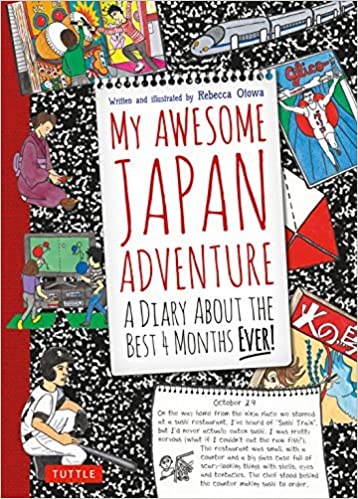
reported by Lisa Wilcut
WiK members gathered on the misty afternoon of March 14 for a lunch talk with Rebecca Otowa at Ume no Hana near Karasuma Oike. The congruence of season and venue hinted at the deep connections with time and place that are a hallmark of Rebecca’s works, which are heavily influenced by the cycles of nature, of seasonal activities, and of family. Her three books were published by Tuttle, the latest due out next week. She’s also started a blog (rebeccaotowa.com) where she continues to write about life in the countryside, Japanese culture, and psychology.
The talk started with the surprise showing of a hidden treasure: Rebecca’s handwritten, hand-illustrated manuscript of the first version of what would undergo a significant transformation and become her first book, At Home in Japan (2010). That original manuscript is a collection of essays about daily life in Japan, arranged by season, each one accompanied by Rebecca’s charming and detailed drawings, and is quite a different creature from the published version.

Her second book, My Awesome Japan Adventure (Tuttle 2013), is the diary of the home-stay experience of an 11-year-old boy. The setting is again rural Japan, and a sense of the season during his four months from autumn into the new year is a strong presence.
While her first two books were explanatory and expository, her third book is a work of fiction that is often grounded in her life. Some of the stories in The Mad Kyoto Shoe Swapper and Other Short Stories (Tuttle, March 2020) were inspired by people she knows and events that happened in her village. Others are works of pure imagination.
Process
In at least one case, Rebecca had an idea of the arc of the story before she started, but for others, she says that her characters usually determine the story, and that they create the situation. She likened her process to a quote from Stephen King, that writing fiction is like following a multi-colored string through the grass.
Unlike King, however, Rebecca says she doesn’t force herself to keep a strict writing schedule. She writes for herself and lets her works take shape organically rather than forcing them into a mold. When once asked during an interview who her intended audience was, she replied, “Well, me! Is that bad?”

On publishing (and persevering)
Reflecting back to her beginnings as a writer, some years ago she had the thought “If I could just publish one book. . .” and along the way, that one book has become three. Rebecca emphasized the power of visualization. When the first book was in the works––a process of several years––she went to bookstores and visualized her book there on the shelves. She says that kind of vision and mindset is very important, and that it’s no use worrying about whether or not your book will sell.
Getting that first book into print started with a connection born from a network. When she was ready to put her manuscript out into the world, someone she knew in Tokyo knew two people who had been published by Tuttle. Meetings were arranged, and the rest, as they say, is history.
Rebecca says her experience with getting her first book published was not the story of countless rejections so often heard about young writers trying to break into print. Although Tuttle rejected the initial version of her first book, they did like the idea of the book itself, and guided it into a different direction. Rebecca says that in reshaping the book, she had to choose between the art and the content. The first version includes a number of delightful and meticulously drawn sketches for each essay. However, she chose to focus on the writing, which she expanded in the process of reshaping the book.
Like Rebecca, John Dougill has also had three books published by Tuttle. Both reported that the experience with each book was different from the last. In some cases, Tuttle had a vision for the book that was quite different from what the writer had in mind, though for other projects, the publisher and/or editor had a rather light hand.
What’s Next?
Plans for the future may include a work on the “Japanese psyche” something Rebecca has been considering for a long time and about which she has pages and pages of ideas waiting in the wings. It was suggested that this might be particularly successful as a work of fiction, followed by the realization that she may have already dipped her toe into those waters with the situations and character sketches in her forthcoming book. She’s been asked about audiobooks and television adaptations of her published books, possibilities that she has not entirely dismissed.

